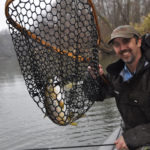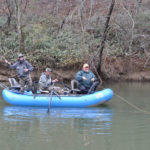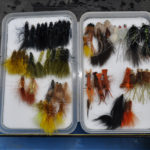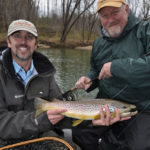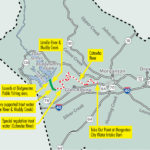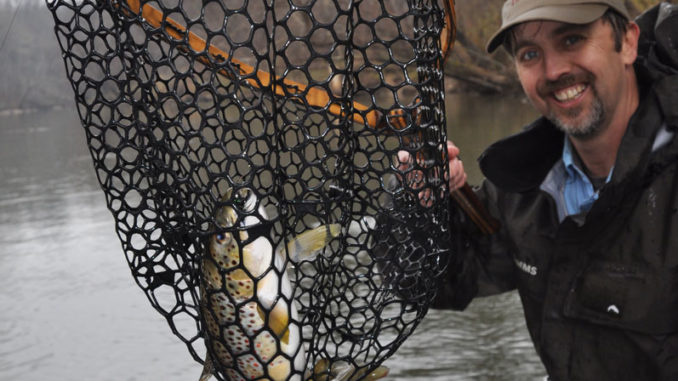
With hatchery supported trout streams closed in March, it’s a great time to fish the special regulations section of the Catawba River.
A pickup towing a trailer carrying two inflatable boats pulled into the parking lot of the Bridgewater Public Fishing Access Area downstream from one of the two dams that impounds Lake James. A cold, rainy morning is not most what most fly-fishermen call ideal, but Scott Cunningham of Marion was excited about being on the water.
“People don’t think about trout fishing this time of year,” said Cunningham, who operates On the Fly Guide Service. “But with hatchery supported trout waters closed, the special regulation trout waters of the Catawba River are wide open. We won’t see any other fishermen today.
“A lot of anglers won’t fish in this weather, but overcast days are best for catching big browns,” he said. “We are going to float through the hatchery supported section of the Linville River to the special regulation section before we begin fishing.”
Cunningham and Chad Stevens of Marion, another guide, were headed for a stretch of river that is North Carolina’s only “special regulation trout water.” The goal is to grow outsized brown trout in what anglers and biologists call a “tailrace” fishery. The N.C. Wildlife Resources Commission stocks the river with rainbow, brook and brown trout, and in the swift, highly oxygenated waters downstream of high-elevation power plants, brown trout grow the fastest and get the biggest.
And while hatchery supported trout waters are open from the first Saturday in April until the last day of February every year, the special regulation waters of the Catawba are open year-round.
From the launching point to the takeout point at the city of Morganton’s water-intake dam, it’s a trip of 8 miles, a long day of fishing in a boat propelled only by the river’s flow and steered with a pair of carbon-fiber oars. Duke Energy’s powerhouse has two hydropower generation turbines, and one, both or — as was the case the morning Cunningham and Stevens were fishing — neither might be operating. With no turbines running, the river was at its lowest flow level, which Cunningham said was best for fishing.
“We might have to push the raft through a rapid or two, but we will get to the good fishing,” Cunningham said. “We should catch lots of brown trout today. We had some flooding in 2004 that hurt the fishing, but it has recovered, thanks to the Commission’s stockings.”
Chris Wood, the Commission’s fisheries biologist for the Foothills area, said Catawba’s waters can be treacherous if you’re not careful.
“I flipped a canoe twice while fishing that stretch,” he said, “but it is a fantastic fishing opportunity. We are managing the Catawba in that area as a classic tailrace fishery. I believe it has the potential to become one of the best waters for catching trophy brown trout in the nation.”
That’s a lofty claim, but Cunningham and Stevens are typically out to prove it.
Muddy Creek is a hatchery supported stream that often lives up to its name. Below its confluence with the Catawba, however, the heavier river flow dilutes the water’s dingy state, and the anglers in the two boats began catching yellow perch, sunfish, largemouth bass and smallmouth. However, in the first few hundred yards of clear water, Muddy Creek was living up to its name. However, once the anglers were downstream of its confluence with the Catawba, the heavier river flow diluted its dinginess. At first, the anglers caught trash fish – yellow perch, sunfish, largemouth bass and smallmouth bass. However, within a few hundred yards of clear water, Ned Connelly of Wilmington lifted his rod against a strike.
The fish fought hard, bending the rod and threatening to wrap the line around a deadfall. Eventually, Stevens netted the fish.
“What a nice brown trout,” he said. “We might catch dozens that size, today. It’s about 12 inches long, which is a good brown, anywhere else Here, it’s just another nice fish.”
Connelly was impressed.
“I have fished all over the nation, including in Kentucky where I was born and raised,” Connelly said. “I enjoy fly-fishing for trout more than anything else, and have caught them all over the North Carolina mountains. But, until now, this has just been an interesting designation and a want-to-go destination on the map to me because I had no way of fishing here.”
One of the biggest problems is access. Cunningham solved the problem with drift boats.
“You can visit the power company’s website to see scheduled flow releases, but they do not guarantee that amount of flow,”Cunningham said. “If they need to make power and turn on one generator or the second generator off-schedule, a wall of water is going to come down that river and, if you are in a canoe or a kayak, you don’t want to get caught. The best flows occur during no power generation, but you can catch some fish with one generator running. You can’t fish with both of them running.”
Cunningham’s favorite fly is a variation of the Woolly Bugger he calls a Catawba Bugger. It is a large, black fly with lead wire tied around the hook shank to orient the hook point-up.
“That keeps the hook from snagging bottom,” he said. “To a trout, it looks like a hellgrammite.”
A hellgrammite is the larval stage of the Dobsonfly. Trout eat many species of flies and their larvae. Marshall Kirksey of Morganton was fishing a nymph beneath a hot-pink strike indicator and catching trout, too, but only browns, no rainbows or brook trout.
“I’ve caught lots of brown trout in this river,” Kirksey said. “I enjoy fly fishing because it is the most-effective way to fish. It is also the most fun.”
The anglers cast to eddies downstream of rocks and logs, as well as to overhangs and seams along the steep drop-offs. They hauled in dozens of big brown trout before they came to the Causby Road Bridge near Glen Alpine.
Anchoring their boats, they waited for a downpour to slacken. Cunningham cast around the bridge supports and caught three trout, including an 18-incher.
“We catch quite a few trout that big, along with dozens of 10- to 12-inchers,” he said. “In a typical day, we catch about 30 trout per boat, and one or two will go 18 inches or longer.”
The anglers ate lunch waiting out the rain, then continued downstream. Connelly’s rod dipped once more. He was casting to a fly hatch in the center of the river where several trout were rising. For a long time, he fought the fish without saying anything.
“He’s got a big one!” shouted Stevens. “I hope he gets it in.”
The fish headed for the bottom. Then it headed for a boulder and then the bank. Connelly kept a tight line as the trout slowly gave up the fight.
“Whew!” Connelly said. “I didn’t want to say anything to jinx the fight, but that’s the biggest brown trout I’ve ever seen, let alone caught.”
The trout was more than 21 inches long. Stevens and Cunningham estimated its weight at greater than 4 pounds.
“That is the biggest trout we’ve seen in six years of fishing the Catawba and second biggest trout we’ve landed in North Carolina,” Cunningham said. “That is one great fish. Just look at those hooked jaws, which show it is a male, and the red adipose fin. I’m so excited that this river has fish like that swimming in it.”
The anglers fishing the special regulation waters are allowed to keep seven trout of any size, but only one longer than 14 inches, they released all of the several dozen fish that were caught.
“Every trout we release will grow bigger, and we want to be able to catch them another day,” Cunningham said. “People are beginning to find out about what an exceptional tailrace fishery we have in the Catawba River and we want to keep it that way.”
DESTINATION INFORMATION
HOW TO GET THERE — From I-40 east of Morganton, take Exit 94 to Dysartsville and head north on SR 1129. Go a half-mile and turn left onto US 70. Go approximately 1 1/2 miles and turn right onto SR 1233. Go approximately 2 1/2 miles along the Lake James dam and turn right onto SR 1223. The parking area for the Bridgewater Public Fishing Access Area is a half-mile down the road.
WHEN TO GO — Most anglers wait until the hatchery supported trout season opens on April 1 because the Linville River from the Lake James powerhouse to Muddy Creek is open for fishing. However, during March, anglers who can hold off from casting on Muddy Creek encounter few anglers in the special regulation waters of the Catawba River that run from the junction of the two streams downstream to the city of Morganton’s water-supply intake dam. The special trout waters designation allows anglers to keep seven fish per day, but only one may exceed 14 inches.
BEST TECHNIQUES — Fly-fishing with a 9-foot, 5-weight rod and reel spooled with floating line is the ticket. A popular local fly is a Catawba Bugger, a variation of the popular Wooly Booger.
FISHING INFO/GUIDES — Scott Cunningham, Chad Stevens, On the Fly Guide Service, 828-659-0059. See also Guides and Charters in Classifieds. For schedules of water releases from Lake James’ two powerhouses, visit www.duke-energy.com/lakes/scheduled-flow-releases.asp.
ACCOMMODATIONS — Quality Inn, 2400 Sterling St., Morganton, 828-437-0171. For camping at Lake James State Park, 828-584-7728.
MAPS — N.C. Wildlife Resources Commission trout maps, http://ncpaws.org/wrcmapbook/FishingAreas.aspx; DeLorme’s North Carolina Atlas and Gazetteer, 800-452-593, www.delorme.com.

